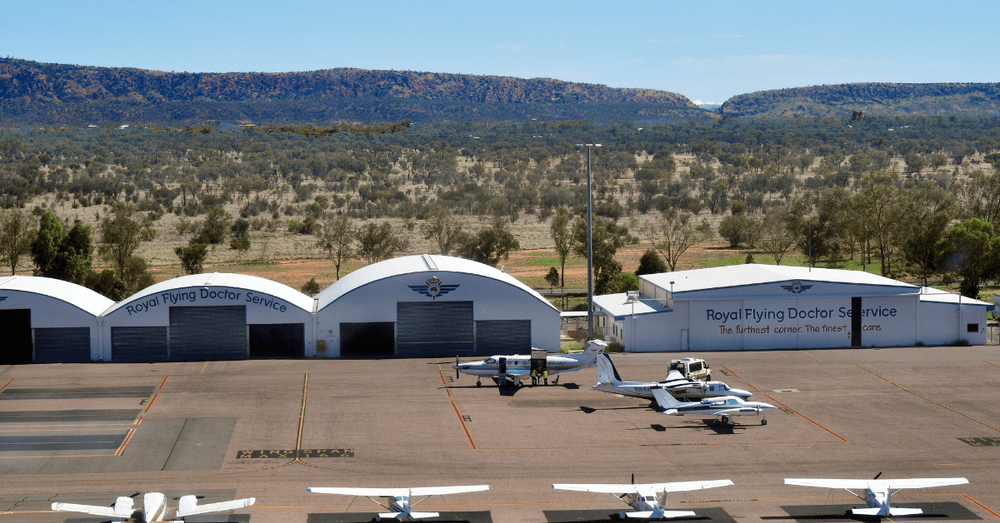The history of the Royal Flying Doctor Service

The Royal Flying Doctors Service (RFDS), is a unique chapter in the history of Australian healthcare. Its inception was driven by a pressing need for medical services in remote regions of Australia, where people live, work, and travel across vast distances.
Two-thirds of the Australian population live around the regional coastlines and the remaining live across rural and remote areas. These settlements are sometimes more than an 8-hour drive to the closest township. Access to health services can be a problem. That's where the Royal Flying Doctor Service comes in.
They see more than 1000 patients daily and have flown the equivalent of 34 trips to the moon and back.
The Royal Flying Doctor service has its own podcast, and a TV series, and features in many Australian Media and books, but where did it all begin?
The RFDS was founded in 1928 by the Reverend John Flynn, a Presbyterian minister who was concerned about the lack of medical care available to people living in remote areas of Australia. At the time, Australia was a vast and sparsely populated country, with many people living in isolated communities that were hundreds of kilometres from the nearest hospital. Flynn recognised that the only way to provide medical care to these people was to use aviation technology, which was then in its infancy.
Flynn had been working with communities in remote areas of Australia. He envisioned a "mantle of safety" that would allow anyone living or working in these remote regions access to primary health care. In 1912, Flynn’s dream was given a boost when he met pilot Lieutenant Clifford Peel, who suggested using aircraft for medical purposes.
St Vincent Welch played an instrumental role in the actualisation of Flynn's vision. As a talented engineer and aviator, Welch was commissioned by Flynn to conduct a survey and propose a plan for the launch of the aerial medical service. After a considerable amount of planning and fundraising, the first RFDS flight took off on 15 May 1928, from Cloncurry, Queensland.
Flynn's vision was to create an airborne medical service that could transport doctors and nurses to rural and remote areas, and bring patients back to hospitals for treatment. He realised that this would require significant investment, and set about raising funds from the public and the government.
The maiden flight's success led to the establishment of a permanent RFDS base in Cloncurry. Here, the service was housed in a small corrugated iron building known as John Flynn's original 'Qantas Hangar.' The base was equipped with a six-bed ward, an operating theatre, and a single aircraft, a de Havilland DH.50 leased from Qantas. The aircraft, equipped with a basic stretcher and medical chest, provided the first ever aerial primary health care service.
The first RFDS flight took place on 17 May 1928, when a pilot named Arthur Affleck flew a De Havilland DH.50 biplane from Cloncurry to Julia Creek in Queensland, carrying a doctor and a nurse. The maiden flight's success led to the establishment of a permanent RFDS base in Cloncurry. Here, the service was housed in a small corrugated iron building known as John Flynn's original 'Qantas Hangar.' The base was equipped with a six-bed ward, an operating theatre, and a single aircraft, a de Havilland DH.50 leased from Qantas. The aircraft, equipped with a basic stretcher and medical chest, provided the first ever aerial primary health care service.
RFDS soon expanded its operations, setting up bases in Alice Springs, Broken Hill, and other rural and remote locations.
Looking for a doctor job that matches your career and lifestyle aspirations?
Search jobsThe early RFDS service relied on pedal radios for communication. The radio system, developed by Alfred Traeger, became the communication lifeline between remote properties and the RFDS.
In the early years, the RFDS faced many challenges, including adverse weather conditions, mechanical problems with its aircraft, and the difficulty of finding qualified medical staff willing to work in remote areas. However, Flynn's determination and the support of the Australian public helped to overcome these obstacles, and the RFDS continued to expand its services.
During World War II, the RFDS played a vital role in providing medical care to Australian troops and civilians in Papua New Guinea and other parts of the Pacific. The service also continued to expand its operations in Australia, adding more bases and aircraft to its fleet.
In the decades that followed, the RFDS continued to evolve, adopting new technologies and medical practices to improve its services. Today, the RFDS operates a fleet of 79 aircrafts, providing medical care to over 387,042 patients every year. The service employs thousands of staff, including doctors, nurses, pilots, and support staff, and has become an essential part of the Australian healthcare system.
The RFDS has also become an important part of Australian culture, featuring in films, television shows, and popular music. The service is celebrated for its contribution to the health and wellbeing of remote and rural communities, and is a source of pride for many Australians.
In 1955, the RFDS was granted the title "Royal" by Queen Elizabeth II, in recognition of its services to the Australian people. Today, the service continues to provide vital medical care to people living in some of the most remote and challenging environments in the world, and is a testament to the resilience and determination of the Australian people.
Over the years, the RFDS has grown exponentially, becoming an iconic symbol of Australian ingenuity and dedication. It is now the largest and most comprehensive aeromedical service in the world, providing primary health care and emergency service to those who live, work, and travel across the vast Australian continent. With a fleet of over 70 aircraft operating from numerous bases across the nation, the RFDS continues to uphold the vision of John Flynn, delivering vital healthcare services to remote and rural communities.
Today, the Royal Flying Doctor Service of Australia operates across numerous regions, including South Australia, New South Wales, Northern Territory, and Western Australia. The organisation has grown significantly since its inception, expanding its South Wales section and integrating Australian Aerial Medical Services to better serve remote communities.
The RFDS provides crucial healthcare services such as emergency medical evacuations, primary healthcare consultations, and telehealth support to residents of rural and remote regions. In addition to direct medical assistance, the service also plays a vital role in bridging the healthcare gap between urban and rural populations, ensuring that those living in the Australian outback have access to quality healthcare.
In essence, the history of the Royal Flying Doctors Service embodies the resilience and innovative spirit of the Australian people, bridging distances, and connecting remote communities to vital medical services. The journey that started in a small town in Cloncurry, Queensland, has become a beacon of hope and care for countless Australians.
The Royal Flying Doctor Service's impact is felt throughout the country, thanks to the tireless dedication of its staff and the ongoing support of the Australian government and generous donors. As a result, this aerial medical service remains a lifeline for countless individuals living in remote areas of Australia.
